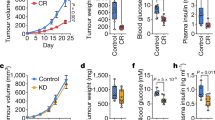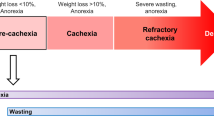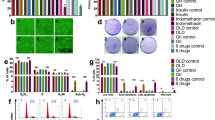Abstract
An attempt has been made to reverse cachexia and to selectively deprive the tumour of metabolic substrates for energy production by feeding a ketogenic regime, since ketone bodies are considered important in maintaining homeostasis during starvation. As a model we have used a transplantable mouse adenocarcinoma of the colon (MAC 16) which produces extensive weight loss without a reduction in food intake. When mice bearing the MAC16 tumour were fed on diets in which up to 80% of the energy was supplied as medium chain triglycerides (MCT) with or without arginine 3-hydroxybutyrate host weight loss was reduced in proportion to the fat content of the diet, and there was also a reduction in the percentage contribution of the tumour to the final body weight. The increase in carcass weight in tumour-bearing mice fed high levels of MCT was attributable to an increase in both the fat and the non-fat carcass mass. Blood levels of free fatty acids (FFA) were significantly reduced by MCT addition. The levels of both acetoacetate and 3-hydroxybutyrate were elevated in mice fed the high fat diets, and tumour-bearing mice fed the normal diet did not show increased plasma levels of ketone bodies over the non-tumour-bearing group despite the loss of carcass lipids. Both blood glucose and plasma insulin levels were reduced in mice bearing the MAC16 tumour and this was not significantly altered by feeding the high fat diets. The elevation in ketone bodies may account for the retention of both the fat and the non-fat carcass mass. This is the first example of an attempt to reverse cachexia by a diet based on metabolic differences between tumour and host tissues, which aims to selectively feed the host at the expense of the tumour.
This is a preview of subscription content, access via your institution
Access options
Subscribe to this journal
Receive 24 print issues and online access
$259.00 per year
only $10.79 per issue
Buy this article
- Purchase on Springer Link
- Instant access to full article PDF
Prices may be subject to local taxes which are calculated during checkout
Similar content being viewed by others
Rights and permissions
About this article
Cite this article
Tisdale, M., Brennan, R. & Fearon, K. Reduction of weight loss and tumour size in a cachexia model by a high fat diet. Br J Cancer 56, 39–43 (1987). https://doi.org/10.1038/bjc.1987.149
Issue Date:
DOI: https://doi.org/10.1038/bjc.1987.149
This article is cited by
-
Impact of a ketogenic diet intervention during radiotherapy on body composition: V. Final results of the KETOCOMP study for head and neck cancer patients
Strahlentherapie und Onkologie (2022)
-
Ketogenic diets consumed during radio-chemotherapy have beneficial effects on quality of life and metabolic health in patients with rectal cancer
European Journal of Nutrition (2022)
-
Exogenous Ketone Supplements in Athletic Contexts: Past, Present, and Future
Sports Medicine (2022)
-
Diet-related interventions for cancer-associated cachexia
Journal of Cancer Research and Clinical Oncology (2021)
-
From bedside to battlefield: intersection of ketone body mechanisms in geroscience with military resilience
GeroScience (2021)



